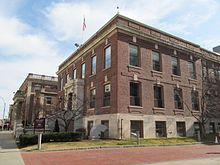Harvard School of Dental Medicine
Boston , , United States 42°20′10″N 71°06′08″W / 42.336095°N 71.102126°W | |
| Website | hsdm |
|---|---|
The Harvard School of Dental Medicine (HSDM) is the
History
This section needs additional citations for verification. (July 2017) |
First university-based dental school
In the early 19th century a dentist was culturally understood as a

Even
A similar evolution happened in dentistry, as dentists today are required to understand a large amount of
The move towards university-based dental education institutions (as they exist today) began with the formation of Harvard Dental School in 1867.
- There was a time when the mouth, relatively speaking, was considered a scientific "no-man's land." That was when dental education fell between academic chairs--literally between the eyes, ears, nose and throat. In the United States dentistry was denied the academic status of other segments of higher education until 1867, when Harvard established the first dental school affiliated with a university-based faculty of medicine.[3]
Origins of DMD degree
Harvard was the first dental school to award the
Renaming the school
The school was established as Harvard Dental School in 1867, but renamed the Harvard School of Dental Medicine in 1940.[6] This symbolic change was made to emphasize the biological basis of oral medicine and the increasingly multidisciplinary focus of dental research.
Expansion of postdoctoral educational programs
In 1957, Harvard School of Dental Medicine was awarded a training grant from the National Institute of Dental Research (now the National Institute of Dental and Craniofacial Research) to expand its postdoctoral training programs. These new programs included an oral and maxillofacial surgery/MD/general surgery residency program; a Doctor of Medical Sciences (DMSc) degree; and 3- and 4-year joint-degree programs with an emphasis on combining clinical training with research into health policy, public health, and/or biomedical sciences.
The school's current post-doctoral programs include both school-based and hospital based residencies. School-based programs award the Master of Medical Science (MMSc) degree, with an optional Doctor of Medical Sciences (DMSc) degree available for those spending extra time on research activities.
Harvard Odontological Society
The Harvard Odontological Society was established in 1878 to promote education and good fellowship amongst graduates and faculty of the Harvard School of Dental Medicine. In continuous operation for over 130 years, the society meets four times a year in a Boston, Massachusetts venue to hold a regular business meeting and an educational presentation of interest to its members.
Harvard Dental Alumni Association
The Harvard School of Dental Medicine has an active group of over 2500 alumni who continue to participate in the day-to-day events of the school and are major contributors to the school's vision and goals for the new millennium. In addition to publishing a quarterly bulletin, marking the current events of the school as well as the achievements of alumni, the Association also sponsors the annual Gold Medal and Silver Medal awards at graduation, honoring the valedictorian and salutatorian of the graduating class, respectively.
Education
School-based programs
- Doctor of Dental Medicine (DMD)
- Orthodontics
- Endodontics
- Prosthodontics
- Periodontics
- Dental Public Health
Hospital-based programs
- Oral and Maxillofacial Surgery at Massachusetts General Hospital and Boston Children's Hospital, with MD degree awarded from Harvard Medical School
- Pediatric Dentistryat Boston Children's Hospital
- Veterans Administration Hospital
Major changes in predoctoral curriculum 1994
In 1994, a major change in the predoctoral curriculum included an increase of the predoctoral class size to 35, introduction of problem-based curriculum, and a switch from a 5-year program to a 4-year case-based curriculum.
Early graduates
- Varaztad Kazanjian, pioneer in plastic surgery, Harvard's first Professor of Plastic Surgery, DMD 1905
- Robert Tanner Freeman, first African-American graduate, DMD 1869
- Nathan Cooley Keep, founder and first Dean of Harvard Dental School, DMD 1870 (Honorary)
- George Franklin Grant, first African-American faculty member at Harvard University, DMD 1870
- Kurt Hermann Thoma, founder of American Board of Pathology, DMD 1911
Affiliated organizations
- American Student Dental Association
- Harvard Odontological Society
See also
References
- ^ "Barber-surgeons". www.sciencemuseum.org.uk. Retrieved 8 January 2016.
- ISBN 9780309051958. Retrieved 8 January 2016.
- PMID 895825.
- ^ "DMD Program". School of Dentistry. Oregon Health & Science University. Retrieved 8 January 2016.
- PMID 10612944.
- ^ "Dental School". Harvard University Library. Harvard University. p. 225. Retrieved 8 January 2016.
